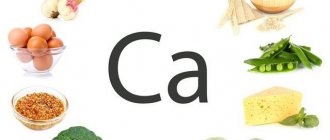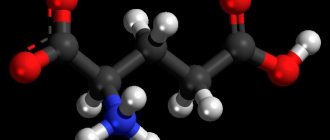The role of vitamin K in the body
In the circulatory system it maintains normal rheological properties of blood. Regulates the coagulation mechanism, preventing the development of internal and external bleeding when the integrity of the vessel is violated. Therefore, it is also prescribed to pregnant women during childbirth and newborn children to prevent the development of complications in the form of possible hemorrhagic diathesis and bleeding.
Effect on the skeletal system . Taking part in the synthesis of the protein osteocalcin, vitamin K ensures rapid restoration of bone tissue in the body. Prevents arterial calcification and the development of osteoporosis.
Metabolic properties . Regulates many redox reactions in the body. It has an antibacterial effect and can relieve pain. Improves kidney function.
Neutralization of toxic substances . Vitamin K neutralizes and neutralizes the toxic effects of coumarin, aflatoxin and some other toxic substances that accumulate in the body.
Protection against cancer . Because aflatoxins play a significant role in the development of cancer pathology, and vitamin K neutralizes them at the stage of passing through the liver, we can say that it prevents to some extent the development of cancer.
Vitamin K - why the body needs it
Vitamin K belongs to the group of fat-soluble compounds. Under its influence, protein is synthesized and a state associated with blood coagulation processes is ensured. It participates in activities associated with metabolic processes, the place of which are bones and connective tissue.
Without it, the kidneys cannot function normally. This is due to its participation in the processes of calcium absorption and interaction with vitamin D. In the middle of the last century, work carried out by the Danish scientist Henrik Dam was aimed at studying the consequences associated with insufficient cholesterol in chickens. To do this, they were specially kept on a diet that did not contain foods containing cholesterol. As a result, the presence of hemorrhages in the subcutaneous tissue was observed. Even when cholesterol was introduced into the diet, these phenomena did not disappear. But it turned out that cereal grains contain a substance that can eliminate such phenomena. Compounds with the ability to enhance blood clotting were isolated from the products. It is these substances that are called vitamin K.
For the first time, data about them was published in a German publication. Within the walls of the Swiss laboratory where the scientist Carrer conducted research, vitamin K was isolated from alfalfa and called phylloquinone.
Around the same time, American biochemists isolated a compound with slightly different properties, which they had obtained earlier and called vitamin K2.
Information about its chemical structure was first established in 1943. And Dame and Doisy did it, for which they were awarded the Nobel Prize.
The role of vitamin K in the body
Blood clotting processes. Properties associated with strengthening the skeletal system. Construction of pulmonary and cardiac tissue. Vitamin K has an anabolic effect and due to this, it provides energy to all cellular structures. Detoxifying properties associated with detoxification. Its participation in the mechanisms ensuring blood clotting has been established. This provides tissue protection from excessive hemorrhages in case of damage. For this purpose, the vitamin is given to women in labor and newborns. However, if you have hemophilia, it will not give the desired effect.
It helps synthesize the protein osteocalcin. It ensures the formation and restoration of bone structures of the body. This is a means of preventing osteoporosis. Thanks to it, processes associated with redox reactions proceed favorably, normal kidney activity is ensured, proteins are synthesized, which are necessary for the normal functioning of the heart muscle and lungs. It has antibacterial and analgesic properties.
The vitamin has an anabolic effect. Due to it, the body is provided with energy.
When spoiled foods enter the intestines, toxins can damage the liver. These substances can accumulate, and vitamin K helps remove them, thereby protecting tissue structures from damage. It is able to take part in the regulation of blood sugar levels. The vitamin is an effective preventative against inflammatory processes associated with aging of the body. For this reason, it is often called the “vitamin of youth.” It can be synthesized by Escherichia coli, which is a normal inhabitant of the large intestine.
Vitamin K is indicated for conditions associated with the manifestation of hemorrhagic syndrome.
Where is it contained?
It can be found in green leafy vegetables, tomatoes, asparagus, cabbage, and potatoes. It is found in olive oil and green tea. Animal sources include milk and dairy products, chicken eggs and beef liver. A certain part of the compound is synthesized by intestinal microflora.
There is a good combination with fatty foods. In their presence, absorption is more efficient. A medicinal analogue of the vitamin compound is Vikasol, which is found in some multivitamin complexes.
Contraindications
There are also contraindications. It should not be taken by persons with thrombosis and embolism, or with increased blood clotting. We should not forget about hypersensitivity to the drug. A person with average body weight needs about 60 mcg. Conditions associated with its deficiency are rare.
Daily requirement of vitamin K
The required dose of vitamin K for normal functioning of the body is approximately 1 mcg per kilogram of body weight per day.
A typical human diet contains 0.3 to 0.5 mg of vitamin K per day. Therefore, vitamin K deficiency occurs quite rarely , except in cases when nutrition is severely limited or when interacting with certain medications that impair the absorption of the vitamin.
Even without additional food sources, gut bacteria are able to provide the required daily amount of vitamin K.
Breastfed newborns are at risk of developing vitamin K deficiency , since mother's milk contains small amounts of the vitamin, and their intestinal flora is not yet completely perfect.
The daily requirement for the vitamin in newborn babies is 0.01-0.012 mg .
On average, infant formula contains approximately 0.04 mg of vitamin K per 100 kcal. This amount is quite enough to meet the body’s daily need for the vitamin under normal general condition.
| Age | For children | For girls | For guys |
| aged 1-3 years | 15 mcg | — | — |
| from 4 to 6 years | 20 mcg | — | — |
| 7-10 years | 30 mcg per day | — | — |
| 11-14 years old | 45 mcg | — | — |
| 15-18 years old | — | 55 mcg/day | 65 mcg per day |
| 19-23 years old | — | 60 mcg | 70 mcg |
| from 24 years and older | — | 65 mcg per day | 80 mcg/day |
What foods contain vitamin K?
Heat treatment destroys vitamin K. Therefore, the best way to get enough of the microelement is to eat fresh, unheated foods. The highest concentration of the vitamin is found in vegetables and herbs, but only if they have not been frozen or boiled. All types of cabbage, spinach, celery, rose hips, seaweed and many other green plant products are rich in it. Why green? The fact is that the amount of vitamin K is directly proportional to the chlorophyll content: the greener the plant, the more microelement it contains. A lot of vitamin is found in medicinal herbs: alfalfa, pine needles, linden leaves, nettles, raspberries, birch, currants, green tea. Its concentration is quite high in soybeans, cereals, green tomatoes, bananas, cashews and walnuts, prunes, and onions. Non-plant products include pork liver and eggs.
Since vitamin K is broken down only in fats, it is advisable to combine foods rich in it with oils. For example, prepare salads with fresh herbs, seasoning them with sunflower or olive oil, adding soy cheese or olives. Which foods contain the most vitamin K? The table below shows a list of them.
| grocery list | mcg per 100 grams of product |
| brewing green tea | 960 |
| arugula or spinach | 460 |
| White cabbage | 450 |
| green tomato | 400 |
| peas | 340 |
| brewing black tea | 340 |
| soybeans | 240 |
| leafy greens | 210 |
| broccoli | 205 |
| vegetable oil | 200 |
| feather onion | 190 |
| olives | 165 |
| veal meat | 160 |
| beef liver | 155 |
| bulb onions | 150 |
| lamb meat | 145 |
| berries | 130 |
| cilantro or parsley | 110 |
| beef meat | 110 |
| sea fish | 100 |
| horseradish | 100 |
| Cod liver | 95 |
| potato | 90 |
| dog-rose fruit | 85 |
| kelp | 70 |
| cauliflower | 65 |
| corn | 50 |
| asparagus | 45 |
| cucumber | 40 |
| kiwi | 40 |
| celery | 40 |
| walnut or cashew | 35 |
| quail egg | 30 |
| zucchini | 30 |
| date fruit | 25 |
| chicken egg | 25 |
| avocado | 20 |
| red tomato | 15 |
| carrot | 15 |
| chilli | 10 |
| prunes | 10 |
| apple or pear | 5 |
Symptoms of vitamin K deficiency in the body
Vitamin K deficiency can develop in the following pathological conditions:
- obstruction of the gallbladder lumen;
- long-term intravenous administration of drugs (nutrition);
- in cases of impaired synthesis and secretion of bile (various types of hepatitis, cirrhosis, cholelithiasis, oncopathology of the pancreas, biliary dyskinesia);
- with long-term use of antibacterial or sulfonamide medications, which, through their side effects on the body, inhibit the normal intestinal microflora that ensures the production of vitamin K;
- after taking anticoagulants;
- for diseases associated with impaired absorption of fats in the intestines (diarrhea, peptic ulcer, dysentery, pancreatic pathology).
Vitamin K deficiency can also be caused by chemotherapy for cancer, high-dose antibiotic therapy, and the use of anticonvulsants.
Since the vitamin is most closely related to the regulation of the blood coagulation system , clinical signs of its deficiency mainly reflect disturbances in these processes.
If it is insufficiently synthesized or enters the body, the following symptoms may appear:
bleeding gums;
- hypoprothrombinemia (decrease in the level of prothrombin in the blood);
- liquid, dark-colored stool (in newborns);
- bruising on skin surfaces;
- bleeding from the gastrointestinal tract;
- vomiting blood (in newborns);
- painful and prolonged menstruation;
- disruption of the process of digestion and removal of food from the intestines;
- rapid fatigue and severe weakness as a result of developed anemic syndrome.
Causes and consequences of vitamin K deficiency
If you follow the basic principles of a healthy lifestyle, avoid bad habits and maintain a balanced diet, the problem of vitamin K deficiency is practically eliminated. The nutrient will be synthesized by bacteria and ingested with food. However, there are a number of factors in which the absorption of the substance worsens:
- Conducting chemotherapy sessions.
- Long-term use of antibiotics, which impair the functionality of the digestive system.
- Prolonged intravenous nutrition.
- Poor bile synthesis.
- All kinds of poisoning.
- Consuming large amounts of mineral oils.
- Presence of gastrointestinal diseases.
- Acute deficiency of healthy fats.
- Taking medications that reduce the concentration of the vitamin.
Indications for use of vitamin K
General indications for the use of vitamin K-containing preparations for the treatment and prevention of diseases are pathological conditions accompanied by a clinical picture of hemorrhagic syndrome and a decrease in blood prothrombin levels (hypoprothrombinemia).
Indications for the use of vitamin K:
- chronic liver diseases (cirrhosis, hepatitis);
- bleeding from the lungs (with tuberculosis);
- long-term gastrointestinal disorders (such as diarrhea);
- last trimester of pregnancy (prevention of hemorrhagic disease in the newborn);
- prevention of bleeding during preparation for planned surgery;
- blood loss due to injury or surgery;
- septic pathological conditions that are accompanied by hemorrhagic syndrome;
- hemorrhagic diathesis, bleeding gums;
- obstructive jaundice;
- uterine bleeding of various origins;
- bleeding caused by pathological processes in the digestive system (peptic ulcer, various colitis, etc.),
- weakness of the musculoskeletal system;
- bleeding caused by radiation (in acute radiation sickness);
- overdose of indirect anticoagulants and certain drugs (antibacterial agents, salicylates, sulfonamides, sedatives, antituberculosis and anticonvulsants),
- atony of the large and small intestines,
- increased permeability of the vascular wall.
Video: “Vitamin K and blood clotting”
It should be remembered that the use of vitamin K is not effective for such pathologies as hemophilia, Werlhof's disease.
Sources of Vitamin K
Vegetable
Green leafy vegetables remain the richest in vitamin K (from 0.05 to 0.8 mg of vitamin K per 100 g of food).
Vitamin K also contains: green tomatoes, oats, wheat, soybeans, green beans, cabbage, broccoli, avocados, walnuts, fish oil, olive oil, algae, green tea.
Much less is found in root vegetables and fruits . Large amounts of vitamin K accumulate in the leaves of nettle, birch, linden, raspberry, spinach and rose hips.
Animals
Animal products contain much less vitamin K than plant sources . Basically, these are pork and beef liver, eggs, milk and dairy products.
Table of vitamin K content in foods
If you are interested in where vitamin K is found and in which foods its concentration is highest, just look at the following table.
| Product Name (Vitamin K Sources) | Vitamin K content in foods (Vitamin K, mcg/100 g) |
| Horseradish | 108 |
| Broccoli | 88,1 |
| Seaweed | 66 |
| Kiwi | 40,3 |
| cucumbers | 16,4 |
| Cauliflower | 16 |
| Beans | 38,8 |
Most vitamins are found in soybeans and broccoli.
Interaction of vitamin K with other substances
Vitamin K is not an obstacle to the absorption of various substances and goes well with fat-containing foods , which accelerate its metabolism in the body.
A decrease in the absorption of vitamin K is facilitated by:
- strict diets;
- a large amount of vitamin E;
- medications: sleeping pills, antibacterial, anticonvulsants, cardiac and sulfa drugs
- alcoholic, carbonated drinks;
- food preservatives, flavorings, dyes.
Vitamin K itself promotes better absorption of calcium by the body.
Video: “Sources of Vitamin K”
Vitamin K overdose
Since this microelement is rarely found in foods, it is impossible to achieve an overdose of it by eating a specific product. But an overdose can occur when taking a medicated vitamin complex. There is nothing wrong with this - excess substance is easily excreted from the body with urine.
When prescribing certain drugs, the doctor must warn them what their danger is and, most importantly, their incompatibility. Therefore, self-administration of little-known medications is not recommended.
Vitamin and mineral complexes containing vitamin K
Vikasol is often used for treatment . It is a synthetically created analogue of vitamin K ( vitamin K3 )
A distinctive feature of Vikasol, as a water-soluble compound , is that it can be taken parenterally.
Recommended dosages of the drug:
- newborn babies - no more than 4 mg per day;
- children under 1 year – from 2 to 5 mg;
- children under 2 years old - 6 mg;
- at 3-4 years - 8 mg,
- at 5-9 years old – 10 mg,
- at 10-15 years – 15 mg.
For parenteral administration, a single dose is 15 mg, and a daily dose is 30 mg of the vitamin.
Available in the following dosage forms: tablets of 0.015 g and ampoules of 1 ml of 1% solution.
Why does a person need vitamin K?
| You may be interested in: Horoscope for the week from July 6 to July 12, 2020 | |||||
| Aries | Taurus | Twins | Cancer | a lion | Virgo |
| Scales | Scorpion | Sagittarius | Capricorn | Aquarius | Fish |
The benefits of vitamin K were discovered by the Danish scientist Henry Dam. At that time, the substance was credited with being responsible for blood clotting, since it directly affects the formation of the substance prothrombin in the liver. However, over time, research has shown other reasons why fat-soluble vitamin K is essential for men and women of all ages:
- Helps the body absorb calcium and regulates its level;
- Participates in the prevention of bone tissue destruction;
- Prevents rupture of soft tissues;
- Reduces the likelihood of internal bleeding;
- Reduces the volume of menstrual bleeding;
- Used to prevent intracranial bleeding in newborns;
- Neutralizes coumarin, aflatoxins and other poisons that accumulate in the body;
- Prevents cardiovascular diseases;
- Improves episodic memory in Alzheimer's disease.
What foods contain vitamin K?
Since vitamin K is synthesized by intestinal microflora, its deficiency is quite rare. However, if lipid metabolism is disrupted, the body stops accumulating this substance, then it is necessary to use other sources of vitamin K, namely food. Otherwise, the body may become deficient in vitamin K.
Green plant foods are especially rich in vitamin K, which indicates their high chlorophyll content.
- Cabbage: broccoli, kohlrabi, collards, Brussels sprouts, kale, etc.;
- Other vegetables: lettuce, beets, carrots, celery, leeks, green peas, tomatoes, soybeans;
- Greens: parsley, spinach, rose hips, nettle, turnip tops, basil, thyme;
- Fruits: kiwi, avocado, pomegranate juice;
- Animal products: fish oil, eggs, pork liver, cod, hard cheeses, milk;
- Other products: pistachios, cereals, bran.
Is vitamin K destroyed by heat treatment?
- During heat treatment or long-term storage of foods, vitamin K loses about 30% of its beneficial properties.
- Therefore, it is better to eat green vegetables raw and not store food in the refrigerator for a long time.
- Industrial processing of foods will also have a detrimental effect on phylloquinone, so packaged juices are not suitable as a source of vitamin K.
Daily dose of vitamin K
The easiest way to meet your daily requirement of vitamin K is with foods rich in this substance. However, you need to be careful not to cause too much vitamin K in your body, which can have detrimental effects on your health. The daily requirement of vitamin K varies depending on a person’s age.
- From 1 to 3 years, children need only 15 mcg;
- From 4 to 8 years, you need to increase the vitamin K intake to 20 mcg;
- From 9 to 13 years old, 35 mcg should be consumed per day;
- From 14 to 18 years, the dose increases to 55 mcg per day;
- Women over 19 years of age need to consume 65 mcg per day;
- Men 19 years of age and older need 75 mcg per day.
To avoid vitamin K deficiency, after completing a course of antibiotic treatment, the daily norm may increase, since these drugs kill the intestinal microflora, which means they stop the process of vitamin K synthesis.
Lack of vitamin K in the body: signs and symptoms
Vitamin K deficiency can cause unpleasant symptoms and lead to the development of diseases, many of which cannot be cured by replenishing this element in the body. Therefore, it is important to monitor the level of phylloquinone in the blood and regularly consume foods rich in vitamin K. Vitamin K deficiency can be expressed by the following symptoms:
- Frequent nosebleeds;
- Regular and causeless appearance of bruises on the body;
- Bleeding gums;
- Excessive menstrual flow;
- Disorders of calcification of heart valves and blood vessels;
- Frequent bone fractures.
Who is at risk
People with the following diseases need to pay special attention to vitamin K, since its lack in such cases can aggravate the patient’s situation, and a sufficient amount, on the contrary, will allow a positive outcome of the disease:
- Stones in the kidneys;
- Fractures;
- Osteoporosis (low bone density);
- Thrombosis;
- Hardening of the arteries;
- Chronic liver diseases;
- Osteopenia (bone loss);
- Inflammation of intestinal tissue;
- Cancers of the liver and pancreas;
- Cystic fibrosis (damage to organs that produce mucus);
Can there be an excess of vitamin K?
An overdose of vitamin K is most dangerous for older people, because an excess amount of this particular substance can cause blood thickening and thrombosis. Therefore, this category of people should take medications with vitamin K with extreme caution, and during treatment they should be constantly monitored by their doctor.
The main symptoms of hypervitaminosis K are:
- General weakness and lethargy of the body,
- Nausea,
- The appearance of anemia.
However, it is quite difficult to cause an excess of vitamin K. It is very difficult to do this with a diet rich in phylloquinone - foods alone are not enough to cause an overdose. Rarely does an excess of vitamin K occur after consuming dietary supplements, but pharmaceutical preparations use synthetic water-soluble vitamin K - vikasol, which is excreted from the body with fluid.
Vitamin K test
Indications for a vitamin K test are the diagnosis of hypervitaminosis K or hypovitaminosis K. In order to determine the need for this test, you should consult a physician. If there are symptoms of phylloquinone deficiency or excess in adults or children, the doctor will issue a referral for a blood test for vitamin K.
How to prepare
- Venous blood is collected on an empty stomach, so in the morning any food intake is prohibited, you can only drink a small amount of clean water.
- You should also stop drinking alcohol a week before donating blood and not smoking on the day of the test.
- In order to timely diagnose a deviation of vitamin K from the norm, this analysis should be carried out once a year, and more often for women expecting a child and older people.
Vitamin K for pregnant women
Vitamin K is one of the most important vitamins during pregnancy. Since during the period of bearing a child, as well as during childbirth, a woman loses blood, vitamin K, which is responsible for blood clotting, will become the most necessary substance for the body of the expectant mother.
- Vitamin K is part of cell membranes and is involved in the body's energy metabolism, which allows a woman to stay in good shape and lead an energetic lifestyle during pregnancy.
- In addition, vitamin K promotes the formation of fetal bone tissue, which means that its norm is important not only for the mother, but also for the baby.
- However, pregnant women should first ask their doctor how to take vitamin K. You should not self-medicate.
Interesting Facts
The discovery of vitamin K in the twentieth century was preceded by many years of research by scientists on chickens.
- The vitamin got its name from the English word coagulation - coagulation.
- Bile takes an active part in the absorption of vitamin K in the body.
- Most of vitamin K is produced by microorganisms contained in the intestines, and only 20% enters the body with food.
- 20 g of parsley contains 1.5 times the daily value of vitamin K.
- Long-term low-fat diets and consumption of foods containing preservatives sharply reduce the level of vitamin K in the body.
- Athletes really need vitamin K because... it significantly reduces the risk of bleeding after traumatic injuries and enhances muscle contraction.
Varieties of Vitamin K
Foods naturally contain only two types of vitamin K:
- K1 - phylloquinone;
- K2 - menaquinone.
It is difficult to say which one brings more benefits to the body. In fact, these two types are similar in action: they actively participate in blood clotting and play an important role in the formation of heart muscle and bone tissue.
However, there are also differences. Phylloquinone is of plant origin. It accounts for up to 90% of the total amount of vitamin K contained in food. True, a person assimilates only a small part - only 10%.
Menaquinone is found in animal products and is additionally produced by bacteria in the intestines. It is better absorbed than K1 because it has increased fat solubility. Almost all of plant vitamin K1 is deposited in the liver and is quickly decomposed, while menaquinone is used by the body for a long time.
Vitamin K3 (menadione) and vitamin K4 (menadiol diacetate) are synthetic. They perform their main function, which is to increase blood clotting and produce prothrombin and proconvertin.
On a note! In pharmacology, vitamin K3 is usually used, which is the drug “Vikasol”. It is prescribed for fractures, stomach ulcers, radiation sickness, bleeding and after operations.










